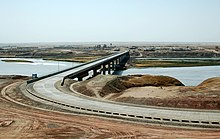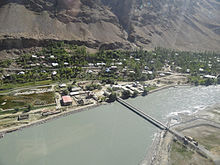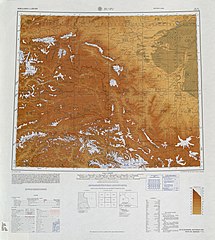
The Afghanistan–Tajikistan border is 1,357 km (843 mi) in length and runs from the tripoint with Uzbekistan in the west to the tripoint with the Xinjiang region of China in the east, almost entirely along the Amu Darya, Pyanj and Pamir Rivers, except for the easternmost section along the Wakhan Corridor and divides the ethnic Tajik community into citizens of two separate countries.
Description
The border begins in the west at the tripoint with Uzbekistan on the Amu Darya. It continues along the thalweg of this river, which flows in a broadly eastwards direction, until it reaches the junction with the Vakhsh River. Hereafter the boundary continues along Pyanj river for 1,080 km (670 mi), the surrounding area becoming increasingly mountainous as the river traces a huge horse-shoe shape, up to the confluence with the Pamir River near the Afghan village of Gaz Khun. The boundary follows the Pamir for 71 km (44 mi) eastwards as far as Lake Zorkul (Sir-i-kol). The boundary then goes overland for 218 km (135 mi) up to the Chinese tripoint, mainly following various mountain peaks and ridges. The border's eastern terminus is found at the Afghanistan-China-Tajikistan tripoint on Povalo-Shveikovskogo Peak (Chinese: 波万洛什维科夫斯基峰; pinyin: Bōwànluò Shíwéikēfūsījī Fēng) / Kokrash Kol Peak (Kekelaqukaole Peak; Chinese: 克克拉去考勒峰; pinyin: Kèkèlāqùkǎolè Fēng).
Much of the boundary is paralleled by Tajikistan's Pamir Highway.
History
The border was inherited from the old Soviet Union-Afghan border, which largely took its current shape during the 19th century Anglo-Russian rivalry in Central Asia, known as the Great Game. With the Russian Empire having conquered the Khanate of Khiva and the Emirate of Bukhara, and with the British Empire controlling the British Raj, the two powers agreed to leave Afghanistan as an independent buffer state between them.
In 1873 Britain and Russia agreed on a rough formulation of the border, with the Amu Darya declared to be the border going east from the vicinity of the village of Khwaja Salar to Lake Zorku, with the Wakhan Corridor to remain in Afghanistan. The western section of the border (i.e. the bulk of the modern Afghan-Turkmen boundary) was to be determined at a later date by a boundary commission.
Tensions mounted as the Russians expanded further into what is now Turkmenistan in the early 1880s, reaching a crisis with the Panjdeh incident (near Sandykachi in what is now Turkmenistan), an area claimed by Afghanistan. Discussions calmed the situation and a joint Anglo-Russian boundary commission demarcated the boundary as it is today over the period 1884–87. As the village of Khwaja Salar could no longer be identified it was agreed that the boundary should meet the Amu Darya in the vicinity of Khamiab, Afghanistan.
The easternmost section of the border (now forming part of the Afghan-Tajik boundary) was not finally delimited until 1893–95, with the Afghans agreeing to waive any claims to lands north of the Amu Darya. This agreement also stipulated the position of the land border in section east of Lake Zorkul up to China, with a series of boundary pillars subsequently erected.
In 1921, a Soviet-Afghan treaty was signed whereby Russia agreed "to hand over to Afghanistan the frontier districts which belonged to the latter in the last century, observing the principles of justice and self-determination of the population inhabiting the same." However, this treaty was never implemented, and was explicitly annulled by the Frontier Agreement of 1946, which kept the boundary as it was, with riverine islands to be subsequently allocated by a joint commission.
The border area was extremely volatile in the 1990s due to the Tajikistani Civil War and the Afghan Civil War. Security improved with the end of the Tajik war and the fall of the Taliban government in 2001; however the long, porous frontier remains poorly policed and is a major drug smuggling route. There have also been a number of incidents related to the Taliban insurgency in Afghanistan. Russia formerly assisted with policing it prior to 2005, and there have been recent reports that China may now be assisting with border policing. Several new border crossing and bridges have built in recent years in an effort to boost trade and links, partly funded by foreign governments and the Aga Khan Development Network.
In July 2021, many Afghan troops and government employees crossed the border into Tajikistan after the 2021 Taliban offensive. In response, Tajikistan's government stationed extra troops near the border.
Border crossings
Further information: Land border crossings of Afghanistan
- Sher Khan Bandar—Panji Poyon (road, see Tajik–Afghan bridge at Panji Poyon)
- Shighnan—Khorugh (road, see Tajik–Afghan bridge at Tem-Demogan)
- Ishkashim—Ishkoshim (road)
- Ai Khanoum—Kokul (ferry only)
- Tajik-Afghan Friendship Bridge (road)
Settlements near the border
Afghanistan
- Baghri Kol
- Kolukh Teppe
- Sher Khan Bandar
- Shah Ravan
- Chichkeh
- Dasht-e-Qaleh
- Kvahan
- Khosfav
- Arakhat
- Ishkashim
Tajikistan
- Ayvadzh
- Panji Poyon
- Dusty
- Panj
- Parkhar
- Kishti Royen
- Qal'ai Khumb
- Kevron
- Rushon
- Bazhdu Pavdiv
- Khorugh
- Ishkoshim
- Sinib
History maps
Historical English-language maps of the Afghanistan-Tajik SSR border, mid to late 20th century:
See also
- Afghanistan–Tajikistan relations
- Extreme points of Afghanistan
- Extreme points of Tajikistan
- Sarikol Range
References
- CIA World Factbook – Afghanistan, 8 September 2018, archived from the original on 4 January 2021, retrieved 24 January 2021
- Kamoludin Abdullaev (2018). Historical Dictionary of Tajikistan (3 ed.). Rowman & Littlefield. p. 92. ISBN 9781538102527 – via Google Books.
CHINA-TAJIK BORDER.{...}This mountainous boundary runs along the Sarikol mountain range in eastern Tajikistan, reaching in Pamir the Afghan border at the Povalo-Shveikovskogo peak (5,543 meters above sea level).
- "NJ 43 Su-fu [U.S.S.R., China, Afghanistan, Pakistan, State of Jammu and Kashmir] Series 1301, Edition 5-AMS". Washington, D. C.: Army Map Service. March 1967. Archived from the original on 2019-10-13. Retrieved 2020-01-11 – via Perry–Castañeda Library Map Collection.
Pik Povalo-Shveikovskogo
- 中华人民共和国和阿富汗王国边界条约 (in Chinese). 22 November 1963. Archived from the original on 4 November 2020. Retrieved 12 August 2021 – via Wikisource.
到高程为5698米的克克拉去考勒峰(阿方图称波万洛什维科夫斯基峰)。
- 阿富汗 (in Simplified Chinese). State Ethnic Affairs Commission. 6 July 2004. Archived from the original on 4 December 2008.
中阿边界{...}南起中、巴、阿3国交界处的5587山峰,沿穆斯塔格山脉分水岭北行至克克拉去考勒峰。
- "China Report Political, Sociological and Military Affairs No. 363" (PDF). United States Joint Publications Research Service. 18 November 1982. p. 1. Archived (PDF) from the original on 11 January 2020. Retrieved 11 January 2020 – via Defense Technical Information Center.
If we open up the Atlas of the People's Republic of China we will find that the region of the Pamir, the western extremity of Xinjiang, from the Wuzibieli Pass1 to the south down to the Kekelaqukaole Peak (which the Soviet Russians call "Pavel Shveikovsky Peak") is designated as a not limited area.
- ^ International Boundary Study No. 26 – Afghanistan-USSR Boundary (PDF), 15 September 1983, archived (PDF) from the original on 9 September 2018, retrieved 8 September 2018
- Global Risk Insights – Under the Radar: Tajikistan on track to be the next Afghanistan, 19 March 2017, archived from the original on 29 August 2018, retrieved 8 September 2018
- Pirnazarov, Nazarali (21 April 2016), "Reuters – Barely guarded Afghan border puts ex-Soviet Tajikistan in peril", Reuters, archived from the original on 20 September 2018, retrieved 8 September 2018
- The Jamestown Foundation – What Is China's Military Doing on the Afghan-Tajik Border, archived from the original on 9 February 2018, retrieved 8 September 2018
- AKDF – Linking Communities, Lighting Lives: Electrifying the Tajik-Afghan Borde, 24 November 2017, retrieved 8 September 2018
- "Tajikistan Asks CSTO for Assistance on the Afghan Border". Archived from the original on 2021-07-12. Retrieved 2021-07-12.
- Caravanistan – Tajikistan-Afghanistan border crossings, archived from the original on 13 May 2019, retrieved 8 September 2018
Further reading
| Borders of Afghanistan | |
|---|---|
| Borders of Tajikistan | |
|---|---|

